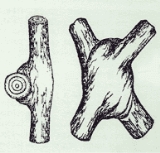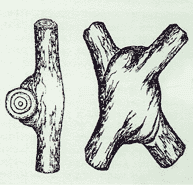
Inosculation
Encyclopedia

Tree
A tree is a perennial woody plant. It is most often defined as a woody plant that has many secondary branches supported clear of the ground on a single main stem or trunk with clear apical dominance. A minimum height specification at maturity is cited by some authors, varying from 3 m to...
s grow together. When occurring in plants, it is biologically very similar to grafting
Grafting
Grafting is a horticultural technique whereby tissues from one plant are inserted into those of another so that the two sets of vascular tissues may join together. This vascular joining is called inosculation...
.
It is most common for branches of two trees of the same species
Species
In biology, a species is one of the basic units of biological classification and a taxonomic rank. A species is often defined as a group of organisms capable of interbreeding and producing fertile offspring. While in many cases this definition is adequate, more precise or differing measures are...
to grow together, though inosculation may be noted across related species. The branches first grow separately in proximity to each other until they touch. At this point, the bark on the touching surfaces is gradually abraded away as the trees move in the wind. Once the cambium
Vascular cambium
The vascular cambium is a part of the morphology of plants. It consists of cells that are partly specialized, for the tissues that transport water solutions, but have not reached any of the final forms that occur in their branch of the specialization graph...
of two trees touches, they self-graft and grow together. Inosculation customarily results when tree limbs are braided or pleached
Pleaching
Pleaching is a technique to weave the branches of trees into a hedge or to form a quincunx. Commonly, deciduous trees are planted in lines, then pleached to form a flat plane on clear stems above the ground level. Branches are woven together and lightly tied...
.
The term "inosculation" is also used in the context of plastic surgery
Plastic surgery
Plastic surgery is a medical specialty concerned with the correction or restoration of form and function. Though cosmetic or aesthetic surgery is the best-known kind of plastic surgery, most plastic surgery is not cosmetic: plastic surgery includes many types of reconstructive surgery, hand...
, as one of the three mechanisms by which skin grafts take at the host site. Blood vessels from the recipient site are believed to connect with those of the graft in order to restore vascularity.
Species
Inosculation is most common among the following species of tree due to their thin bark.- AppleAppleThe apple is the pomaceous fruit of the apple tree, species Malus domestica in the rose family . It is one of the most widely cultivated tree fruits, and the most widely known of the many members of genus Malus that are used by humans. Apple grow on small, deciduous trees that blossom in the spring...
- AlmondAlmondThe almond , is a species of tree native to the Middle East and South Asia. Almond is also the name of the edible and widely cultivated seed of this tree...
- BeechBeechBeech is a genus of ten species of deciduous trees in the family Fagaceae, native to temperate Europe, Asia and North America.-Habit:...
- Crepe myrtle
- DogwoodDogwoodThe genus Cornus is a group of about 30-60 species of woody plants in the family Cornaceae, commonly known as dogwoods. Most dogwoods are deciduous trees or shrubs, but a few species are nearly herbaceous perennial subshrubs, and a few of the woody species are evergreen...
- ElmElmElms are deciduous and semi-deciduous trees comprising the genus Ulmus in the plant family Ulmaceae. The dozens of species are found in temperate and tropical-montane regions of North America and Eurasia, ranging southward into Indonesia. Elms are components of many kinds of natural forests...
- GrapeGrapeA grape is a non-climacteric fruit, specifically a berry, that grows on the perennial and deciduous woody vines of the genus Vitis. Grapes can be eaten raw or they can be used for making jam, juice, jelly, vinegar, wine, grape seed extracts, raisins, molasses and grape seed oil. Grapes are also...
- HazelnutHazelnutA hazelnut is the nut of the hazel and is also known as a cob nut or filbert nut according to species. A cob is roughly spherical to oval, about 15–25 mm long and 10–15 mm in diameter, with an outer fibrous husk surrounding a smooth shell. A filbert is more elongated, being about twice...
- HornbeamHornbeamHornbeams are relatively small hardwood trees in the genus Carpinus . Though some botanists grouped them with the hazels and hop-hornbeams in a segregate family, Corylaceae, modern botanists place the hornbeams in the birch subfamily Coryloideae...
- LaburnumLaburnumLaburnum is a genus of two species of small trees in the subfamily Faboideae of the pea family Fabaceae, Laburnum anagyroides and L. alpinum . They are native to the mountains of southern Europe from France to the Balkan Peninsula...
- LindenTiliaTilia is a genus of about 30 species of trees native throughout most of the temperate Northern Hemisphere. The greatest species diversity is found in Asia, and the genus also occurs in Europe and eastern North America, but not western North America...
- MapleMapleAcer is a genus of trees or shrubs commonly known as maple.Maples are variously classified in a family of their own, the Aceraceae, or together with the Hippocastanaceae included in the family Sapindaceae. Modern classifications, including the Angiosperm Phylogeny Group system, favour inclusion in...
- OliveOliveThe olive , Olea europaea), is a species of a small tree in the family Oleaceae, native to the coastal areas of the eastern Mediterranean Basin as well as northern Iran at the south end of the Caspian Sea.Its fruit, also called the olive, is of major agricultural importance in the...
- PeachPeachThe peach tree is a deciduous tree growing to tall and 6 in. in diameter, belonging to the subfamily Prunoideae of the family Rosaceae. It bears an edible juicy fruit called a peach...
- PearPearThe pear is any of several tree species of genus Pyrus and also the name of the pomaceous fruit of these trees. Several species of pear are valued by humans for their edible fruit, but the fruit of other species is small, hard, and astringent....
- PrivetPrivetPrivet was originally the name for the European semi-evergreen shrub Ligustrum vulgare, and later also for the more reliably evergreen Ligustrum ovalifolium , used extensively for privacy hedging. It is often suggested that the name privet is related to private, but the OED states that there is no...
- River Red GumRiver Red GumThe River Red Gum is a tree of the genus Eucalyptus. It is one of around 800 in the genus. It is a plantation species in many parts of the world, but is native to Australia, where it is widespread, especially beside inland water courses...
- SycamoreSycamoreSycamore is a name which is applied at various times and places to three very different types of trees, but with somewhat similar leaf forms....
- WillowWillowWillows, sallows, and osiers form the genus Salix, around 400 species of deciduous trees and shrubs, found primarily on moist soils in cold and temperate regions of the Northern Hemisphere...
- WisteriaWisteriaWisteria is a genus of flowering plants in the pea family, Fabaceae, that includes ten species of woody climbing vines native to the eastern United States and to China, Korea, and Japan. Aquarists refer to the species Hygrophila difformis, in the family Acanthaceae, as Water Wisteria...
Conjoined trees
Two trees may grow to their mature size adjacent to each other and seemingly grow together or conjoin, demonstrating the process of inosculation. These may be of the same species or even trees of two different genera or families, depending on whether the two trees that have become truly grafted together (once the cambiumVascular cambium
The vascular cambium is a part of the morphology of plants. It consists of cells that are partly specialized, for the tissues that transport water solutions, but have not reached any of the final forms that occur in their branch of the specialization graph...
of two trees touches, they self graft and grow together) or not. Usually grafting is only between two trees of the same or closely related species or genera, however the appearance of grafting can be given by two trees that are physically touching , rubbing, intertwined, or entangled. Both conifers and deciduous trees can become conjoined. Beech trees in particular are frequent conjoiners. Inosculation occurs in blackthorn (Prunus spinosa).

Examples
At the ruined Lynncraigs Farm, Dalry, North AyrshireDalry, North Ayrshire
Dalry is a small town in the Garnock Valley in Ayrshire, Scotland.-History:Dalry means "King's Valley" or more simply the "Rye Meadow"; indicating a small settlement on the Rye Burn. Its history has signs of early inhabitants in the area...
in Scotland
Scotland
Scotland is a country that is part of the United Kingdom. Occupying the northern third of the island of Great Britain, it shares a border with England to the south and is bounded by the North Sea to the east, the Atlantic Ocean to the north and west, and the North Channel and Irish Sea to the...
, a blackthorn (Prunus spinosa) stands in the old farm garden which shows signs of having been deliberately grafted.
On his Tour of Scotland, published in 1800, T. Garnett notes a tree near Inverary that the locals called the Marriage tree, formed from a lime tree with two trunks that have been joined together by a branch in the manner of a person putting their arm around another (see illustration) as would a married couple.
On the way to the Heavenly Lake near Urumqi
Ürümqi
Ürümqi , formerly Tihwa , is the capital of Xinjiang Uyghur Autonomous Region of the People's Republic of China, in the northwest of the country....
in China are a pair of trees that local people have called the Husband and Wife trees because they are connected together by a living branch. The Tatajia Husband and Wife trees are in Taiwan
Taiwan
Taiwan , also known, especially in the past, as Formosa , is the largest island of the same-named island group of East Asia in the western Pacific Ocean and located off the southeastern coast of mainland China. The island forms over 99% of the current territory of the Republic of China following...
and in Yakushima, Kagoshima-ken, Japan
Japan
Japan is an island nation in East Asia. Located in the Pacific Ocean, it lies to the east of the Sea of Japan, China, North Korea, South Korea and Russia, stretching from the Sea of Okhotsk in the north to the East China Sea and Taiwan in the south...
, are a pair of Husband and Wife trees formed from conjoined cedars. The Marriage Tree on Wassaw Island
Wassaw Island
Wassaw Island is one of the Sea Islands. It is located on the Atlantic Ocean off the coast of the U.S. state of Georgia and is part of Chatham County. The island and its surrounding marshlands are part of the Wassaw National Wildlife Refuge, which has a total area of of marsh, mudflats, and tidal...
, Georgia, was named by the family who vacationed there and consists of a Bay
Bay tree
Bay tree can refer to:* Bay Laurel, the edible Sweet Bay* Umbellularia, the California Bay Laurel* Bay Tree, a Fabergé eggAnd sometimes confused with the poisonous*Prunus laurocerasus...
and a Palm fused at the root.
Sources
- Garnett, T. (1800). Observations on a Tour of the Highlands and part of the Western Isles of Scotland. London : Cadell & Davies.

